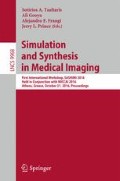Abstract
White matter hyperintensities (WMH) seen on FLAIR images are established as a key indicator of Vascular Dementia (VD) and other pathologies. We propose a novel modality transformation technique to generate a subject-specific pathology-free synthetic FLAIR image from a T\(_1\) -weighted image. WMH are then accurately segmented by comparing this synthesized FLAIR image to the actually acquired FLAIR image. We term this method Pseudo-Healthy Image Synthesis (PHI-Syn). The method is evaluated on data from 42 stroke patients where we compare its performance to two commonly used methods from the Lesion Segmentation Toolbox. We show that the proposed method achieves superior performance for a number of metrics. Finally, we show that the features extracted from the WMH segmentations can be used to predict a Fazekas lesion score that supports the identification of VD in a dataset of 468 dementia patients. In this application the automatically calculated features perform comparably to clinically derived Fazekas scores.
Access this chapter
Tax calculation will be finalised at checkout
Purchases are for personal use only
References
Debette, S., Markus, H.S.: The clinical importance of white matter hyperintensities on brain magnetic resonance imaging: systematic review and meta-analysis. BMJ 341, c3666 (2010)
Cao, T., Zach, C., Modla, S., Powell, D., Czymmek, K., Niethammer, M.: Registration for correlative microscopy using image analogies. In: Dawant, B.M., Christensen, G.E., Fitzpatrick, J.M., Rueckert, D. (eds.) WBIR 2012. LNCS, vol. 7359, pp. 296–306. Springer, Heidelberg (2012)
Roy, S., Carass, A., Prince, J.: A compressed sensing approach for MR tissue contrast synthesis. In: Székely, G., Hahn, H.K. (eds.) IPMI 2011. LNCS, vol. 6801, pp. 371–383. Springer, Heidelberg (2011). doi:10.1007/978-3-642-22092-0_31
Tsunoda, Y., Moribe, M., Orii, H., Kawano, H., Maeda, H.: Pseudo-normal image synthesis from chest radiograph database for lung nodule detection. Adv. Intell. Syst. Comput. 268, 147–155 (2014)
Ye, D.H., Zikic, D., Glocker, B., Criminisi, A., Konukoglu, E.: Modality propagation: coherent synthesis of subject-specific scans with data-driven regularization. In: Mori, K., Sakuma, I., Sato, Y., Barillot, C., Navab, N. (eds.) MICCAI 2013, Part I. LNCS, vol. 8149, pp. 606–613. Springer, Heidelberg (2013)
Fischl, B., Salat, D.H., van der Kouwe, A.J.W., Makris, N., Ségonne, F., Quinn, B.T., Dale, A.M.: Sequence-independent segmentation of magnetic resonance images. Neuroimage 23, S69–S84 (2004)
Nguyen, H., Zhou, K., Vemulapalli, R.: Cross-domain synthesis of medical images using efficient location-sensitive deep network. In: Navab, N., Hornegger, J., Wells, W.M., Frangi, A.F. (eds.) MICCAI 2015. LNCS, vol. 9349, pp. 677–684. Springer, Heidelberg (2015). doi:10.1007/978-3-319-24553-9_83
Kroon, D.-J., Slump, C.H.: MRI modalitiy transformation in demon registration. ISBI 2009, 963–966 (2009)
Roy, S., Carass, A., Prince, J.: Magnetic resonance image example based contrast synthesis. IEEE Trans. Med. Imaging 32(12), 2348–2363 (2013)
Roy, S., Carass, A., Shiee, N., Pham, D.L.: MR contrast synthesis for lesion segmentation. ISBI 2010, 932–935 (2010)
Tustison, N.J., Avants, B.B., Cook, P.A., Zheng, Y., Egan, A., Yushkevich, P.A., Gee, J.C.: N4ITK: improved N3 bias correction. IEEE Trans. Med. Imaging 29(6), 1310–1320 (2010)
Heckemann, R.A., Ledig, C., Gray, K.R., Aljabar, P., Rueckert, D., Hajnal, J.V., Hammers, A.: Brain extraction using label propagation, group agreement: pincram. PloS ONE 10(7), e0129211 (2015)
Ledig, C., Heckemann, R.A., Hammers, A., Lopez, J.C., Newcombe, V.F., Makropoulos, A., Lötjönen, J., Menon, D.K., Rueckert, D.: Robust whole-brain segmentation: application to traumatic brain injury. Med. Image Anal. 21(1), 40–58 (2015)
Rueckert, D., Sonoda, L.I., Hayes, C., Hill, D.L., Leach, M.O., Hawkes, D.J.: Nonrigid registration using free-form deformations: application to breast MR images. IEEE Trans. Med. Imaging 18(8), 712–721 (1999)
Huppertz, H.J., Wagner, J., Weber, B., House, P., Urbach, H.: Automated quantitative FLAIR analysis in hippocampal sclerosis. Epilepsy Res. 97(1), 146–156 (2011)
Heye, A.K., Thrippleton, M.J., Chappell, F.M., Hernández, M., Armitage, P.A., Makin, S.D., Maniega, S.M., Sakka, E., Flatman, P.W., Dennis, M.S., Wardlaw, J.M.: Blood pressure, sodium: association with MRI markers in cerebral small vessel disease. J. Cereb. Blood Flow Metab. 36(1), 264–274 (2016)
Hernández, M.D.C.V., Armitage, P.A., Thrippleton, M.J., Chappell, F., Sandeman, E., Maniega, S.M., Shuler, K., Wardlaw, J.M.: Rationale, design and methodology of the image analysis protocol for studies of patients with cerebral small vessel disease and mild stroke. Brain Behav. 5(12), e00415 (2015)
Schmidt, P., Gaser, C., Arsic, M., Buck, D., Förschler, A., Berthele, A., Hoshi, M., Ilg, R., Schmid, V.J., Zimmer, C., Hemmer, B.: An automated tool for detection of FLAIR-hyperintense white-matter lesions in multiple sclerosis. Neuroimage 59(4), 3774–3783 (2012)
Fazekas, F., Chawluk, J.B., Alavi, A., Hurtig, H.I., Zimmerman, R.A.: MR signal abnormalities at 1.5 T in Alzheimer’s dementia and normal aging. Am. J. Neuroradiol. 8(3), 421–426 (1987)
Author information
Authors and Affiliations
Corresponding author
Editor information
Editors and Affiliations
Rights and permissions
Copyright information
© 2016 Springer International Publishing AG
About this paper
Cite this paper
Bowles, C. et al. (2016). Pseudo-healthy Image Synthesis for White Matter Lesion Segmentation. In: Tsaftaris, S., Gooya, A., Frangi, A., Prince, J. (eds) Simulation and Synthesis in Medical Imaging. SASHIMI 2016. Lecture Notes in Computer Science(), vol 9968. Springer, Cham. https://doi.org/10.1007/978-3-319-46630-9_9
Download citation
DOI: https://doi.org/10.1007/978-3-319-46630-9_9
Published:
Publisher Name: Springer, Cham
Print ISBN: 978-3-319-46629-3
Online ISBN: 978-3-319-46630-9
eBook Packages: Computer ScienceComputer Science (R0)

